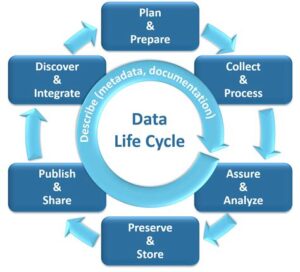Back to: Computer Studies JSS1
Welcome to class!
In today’s class, we shall be talking about another interesting topic- data processing. Please enjoy the class!
Data Processing

In today’s data-driven world, data processing plays a crucial role in extracting valuable information from raw data. It encompasses a series of steps that transform raw data into useful and actionable insights, enabling organizations to make informed decisions, improve efficiency, and gain a competitive edge.
What is Data Processing?
Data processing is the systematic collection, organization, manipulation, and interpretation of data to generate meaningful information. It involves a wide range of activities, including:
- Data collection: Gathering data from various sources, such as sensors, surveys, and transactions.
- Data cleaning: Identifying and correcting errors, inconsistencies, and missing values in the data.
- Data transformation: Converting data into a usable format for analysis and interpretation.
- Data analysis: Extracting patterns, trends, and insights from the data using statistical and analytical techniques.
- Data visualization: Presenting the findings in a clear and understandable way, often using charts, graphs, and maps.
The Data Processing Cycle

Data processing typically follows a cyclical pattern, with each step building upon the previous one:
- Data Collection: The raw data is gathered from various sources, ensuring its accuracy, completeness, and relevance.
- Data Cleaning: The data is subjected to cleaning procedures to identify and rectify errors, inconsistencies, and missing values.
- Data Transformation: The data is transformed into a suitable format for analysis, often involving standardization, normalization, and aggregation.
- Data Analysis: Statistical and analytical techniques are applied to the data to uncover patterns, trends, and insights.
- Data Visualization: The findings are presented in a clear and comprehensible manner using charts, graphs, and maps.
- Data Interpretation: The extracted insights are interpreted and translated into actionable recommendations.
Benefits of Data Processing
Data processing offers numerous benefits to organizations across various industries:
Informed Decision-Making: Data-driven insights empower organizations to make informed decisions, optimize operations, and enhance resource allocation.
Improved Efficiency: Data processing helps identify inefficiencies, streamline processes, and automate tasks, leading to increased productivity and cost savings.
Customer Understanding: Data analysis provides valuable insights into customer behavior, preferences, and needs, enabling businesses to tailor products, services, and marketing strategies effectively.
Competitive Advantage: Data-driven organizations gain a competitive edge by leveraging insights to innovate, adapt to market trends, and anticipate customer demands.
Applications of Data Processing
Data processing finds applications in a wide range of domains:
Finance: Analyzing financial data to assess risk, manage investments, and optimize financial strategies.
Healthcare: Analyzing patient data to identify treatment patterns, predict disease outbreaks, and improve patient outcomes.
Retail: Analyzing customer behavior and purchasing patterns to personalize marketing campaigns, optimize product placement, and enhance customer satisfaction.
Manufacturing: Analyzing production data to identify process bottlenecks, optimize resource utilization, and improve quality control.
Social Sciences: Analyzing social media data, survey responses, and demographic data to understand social trends, public opinion, and human behavior.
Data processing is an essential tool for organizations of all sizes and industries. By transforming raw data into meaningful insights, data processing empowers organizations to make informed decisions, improve efficiency, and gain a competitive edge in the data-driven world.
We have come to the end of today’s class. I hope you enjoyed the class!
In the next class, we shall be discussing Importance of the Computer as a Tool for Data Processing.
In case you require further assistance or have any questions, feel free to ask in the comment section below, and trust us to respond as soon as possible. Cheers!
Question Time:
- What are the different stages of the data processing cycle?
- What are the different types of data processing?
- What are the different methods for data cleaning?
- What are the different data transformation techniques?
- What are the different data analysis techniques?
- What are the different data visualization techniques?
- What are the different tools and technologies used for data processing?
